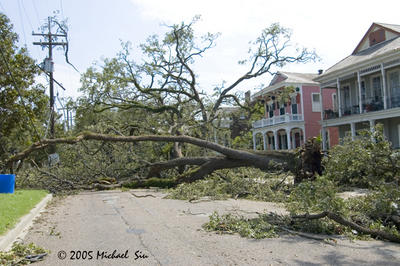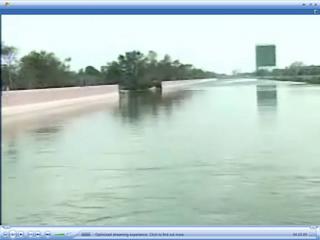Oak St. -- A Stranger Few Days Than Usual
The owner of the hardware store, an old guy who once followed me around the aisles with a suspicious eye, had driven to his store over dry but somewhat littered Riverbend streets to see how it had fared in the storm.
When he got there, the young dudes from the neighborhood were clearing its inventory out. He told them he'd give them whatever they needed--nails, hammers, wood, etc--but asked them not to ruin his livelihood. That's when one of whacked him in the head with a crowbar. Seeing this from down the block, the owner of the Maple Leaf went over with a shotgun and scared off the looters. Reportedly, it looked like they were fixing to kill the store owner. He was okay, and returned shortly thereafter to pile as much of his inventory into a pickup truck. He then drove off down Oak St. with a few buddies in the back--guns drawn.
Meanwhile, a dramatically less murderous (and I reckon drunker) contingent of remaining locals went shopping at the Rite Aid on Oak and Carrolton. With a forklift:
 One resident, who shall remain nameless, said that the store wasn't ransacked as much as shopped-at-without-paying-for-it. Once the door was open, these locals just helped themselves to modest basketfuls of necessary staples: in our friend's case, this was 2 things of Rollos, maybe a toothbrush....all I remember of the list was the Rollos. He said people were just walking up and down the aisles as on any other day, then walking out with their stuff instead of going to the counter first.
One resident, who shall remain nameless, said that the store wasn't ransacked as much as shopped-at-without-paying-for-it. Once the door was open, these locals just helped themselves to modest basketfuls of necessary staples: in our friend's case, this was 2 things of Rollos, maybe a toothbrush....all I remember of the list was the Rollos. He said people were just walking up and down the aisles as on any other day, then walking out with their stuff instead of going to the counter first.
Even on Wednesday, some of those on Oak St. saw no particular reason to leave. The houses were standing and in good shape. There was no electricity, but there were candles. There was plenty of water and beer, and food was availible, if not through strictly legal means. There was even pool volleyball until the groundwater started to rise in certain places by later in the week. However, the battle between almost-normal and almost-Mogadishu resolved in favor of the latter.
The stories started to come in about what was happening across the city. Then the thugs started coming by. Cop cars would drive by the gangs, take one look, and keep going. By late Wednesday and Thursday, the same people who had been contentedly playing pool volleyball in a ghost town started walking down the street to Rite-Aid carrying guns.
It's a shame: a bunch of the people remaining around Oak St. felt that they probably could have been pretty helpful around the neighborhood were it not for the pickup trucks full of kids going around armed to the teeth, looking for people and things to violate. They recognized the kids. They're the neighbors from down the street, the same ones we would buy $25 bikes from (and who would steal them). In the end, things got hairy pretty fast, and a few Oak St. people hopped in a car and got the fuck out of town, having more or less written off all their possessions.

























